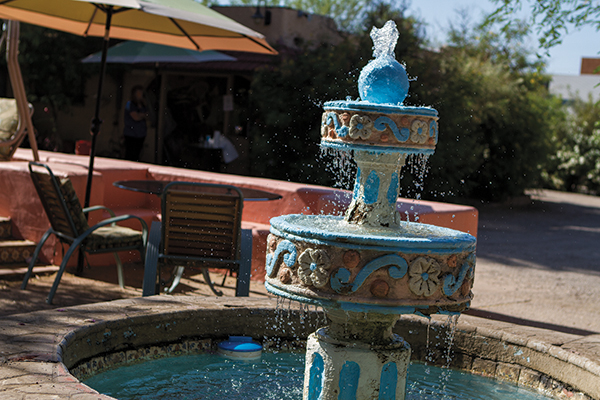
Many Hands Courtyard
Courtyards inspire collaboration inside the lines of special spaces.
One thing is abundantly clear in the weeks ahead – the sun will shock Tucson into a baked city, reprising a predictable May urge to scatter for cool cover. Lucky for us, history’s unbroken practice of gathering in shaded courtyards still thrives in Tucson.
What sets courtyards apart, let’s say, from malls or parks, is the way they enclose you, encouraging you to think carefully about connections to the larger environment of time and place. Roofless and eclectic, courtyards are all around us for both artistic and social ends, extending our living space as semi-private “zócalos.” These odd desert zones also make you feel like you are further away from civilization than you actually are.
So It Begins
By their architectural framework, courtyards offer ventilated environments for commerce, art or well-being. By their history, courtyards have intensified mood and community conversation for more than a century.
One of Tucson’s first was La Plaza de la Mesilla, erected by Mexican residents along the old El Camino Real at the site of the original San Agustín cathedral (nearby what is now the Broadway/Congress intersection). La Placita Village, opened in 1974, symbolically represents Tucson’s first communal gathering point, and the Placita courtyard today remains another gathering point for Tucsonans, via a Thursday evening outdoor film series during summers.
Where there is community conversation there are artists, and in Tucson’s first and most colorful arts enclave, Ash Alley, there were many studios with back courtyards that set the scene for shows and artist gathering. The Contreras family silversmithing business, one of the original Ash Alley studios, identifies the Ash Alley heyday from the 1950s through the 1970s, when parties were hosted with live entertainment on these patios to entice prospective customers. A 1965 Arizona Daily Star article quotes one circa 1950s Ash Alley artist, Jack Petty, as saying, “We used to show paintings at those parties. We’d bring up Mexican gin from Nogales to try to lower visitors’ sales resistance.”
Although Ash Alley is now dominated by parking lots, other courtyards have assumed roles as a center of community life. How could that not be so for a city that itself was one massive walled courtyard in the form of a Spanish Presidio? Courtyards remain a Tucson environment where unintentional encounters happen in intentional places. Why not sit for a spell in one of Zócalo’s choices?
Crafts Collaboration:
Many Hands Courtyard
3054 1st Ave.
www.manyhandscourtyard.com
This home to traditional crafters and shopkeepers began life in the 1950s as the Sunshine Motel. Woodworker Cynthia Haas and partner Joseph Bruno purchased the complex in 1999, refurbishing the rundown adobes into the Many Hands Artist Cooperative, an art school, a furniture repair shop, as well as well as several retail businesses.
The Vibe: Artists in the cooperative gather informally on Thursday mornings, to critique works and to plan activities. Classes for children and adults are often conducted in the landscaped courtyard, which is dotted with tables, chairs and vending machines. Visitors may browse the shops, watch a weaver spin, and also purchase a blended natural, fair trade tea and snacks from Tea and More.
Intriguing Times to Visit: You will find shops and studios open Tuesdays through Saturdays. Third Saturday evening open studios and events are planned through July. Check the website for details about a June photo contest. Many Hands also offers a meeting space for community non-profits.
Field Trip: Nine Courtyards for Collaboration and Community
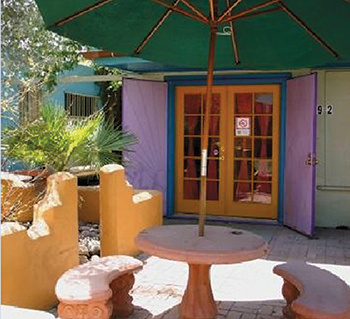
Placita de La Luna
Plein Air Plaza:
Placita de La Luna
2409 North Castro, off Grant
www.placitadelaluna.com
In a 1934 adobe with arches and thick walls hand-formed by Pascua Yaqui artisans, an eclectic mix of oil painters, potters and tattoo artists thrive. There also are service and retail businesses to anchor the complex owned by Greg and Susan Alexander of Maggie Maye’s Tucson Tattoo Studio, which has operated in the complex since 1998.
The Vibe: Native desert landscaping and passive solar elements complement artists, students, customers and visitors who use the courtyard for work and socializing. Often one of the painters will bring a class out to the patio to paint en plein air. Light comes through glass blocks softly while ocotillo metal gates and a gardening project embellish the courtyard surrounded by the original farmhouses.
Intriguing Times to Visit: Check the website for classes offered by the studios. Individual visits to art studios or Susan’s Studio B tattoo salon also may be scheduled by appointment. Some painters have evening classes, and with Maggie Maye’s enclave of tattoo artists open Tuesday through Saturday until 10pm, there is regular access to the courtyard.
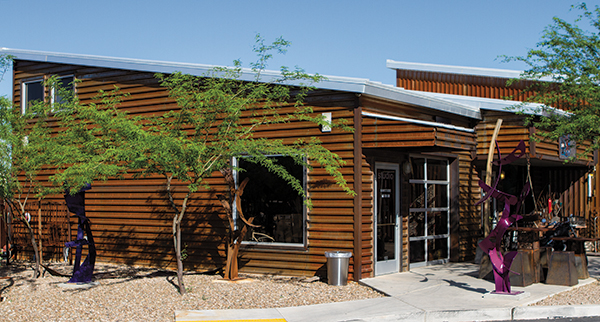
Metal Arts Village
Metal Meet-Up:
Metal Arts Village
3230 North Dodge Blvd.
www.metalartsvillage.com
In 2004, attorney-blacksmith Steve Kimble created this destination for all things metal in the Fort Lowell furniture district. Welders now work alongside glass blowers, woodworkers and metal artists in this specialized community, which includes an outdoor sculpture garden as well as a coffee shop, popular with dog lovers who frequent nearby dog parks.
The Vibe: Kimble’s inspiration for the Village comes from the architecture of old rust belt manufacture and assembly plants. Each of the 11 studios has its own character and is built out of steel. The Coffee Loft, directly off the complex courtyard, serves as a gathering place for the artists who socialize there as well as meet with customers.
Intriguing Times to Visit: Once a week sculptors and designers from across Tucson meet to discuss techniques or opportunities, and formal artist collaborations take place the first Monday of the month at 10am. The coffee shop is open Monday through Saturday, 7am-2pm. Next open studio under the full moon: Saturday, May 25, 6-9pm.
Scribes & Poets:
Casa Libre en la Solana
228 North 4th Ave.
www.casalibre.com
Tucked on the south end of Fourth Avenue, nearby the bars and the foam house, is a history-rich complex that’s also home to a creative and diverse literary salon where people meet for conversation, poetry readings, workshops, art-making and performance. Writer and Casa Libre founder Kristen Nelson purchased the property in 2003, renovating the 1898 property into library and meeting rooms up front, with writer/artist residencies in the back. What was once a dormitory for railroad workers and then a home for retired sex workers, is now the setting for hundreds of literary endeavors hosted each year by the non-profit.
Vibe: There’s a side breezeway and courtyard where youth and adult writers, interested onlookers and visual artists exchange creative energy and participate in diverse programming.
Intriguing Times to Visit: Tucson’s first Trans and Genderqueer Poetry Symposium will be held May 9-12, bringing together contemporary poets from across the country. Edge, a reading series of emerging and younger writers, will host its 54th reading on May 15. Also check the website for workshops, including a June journaling and sketching class for writers of all skill levels.
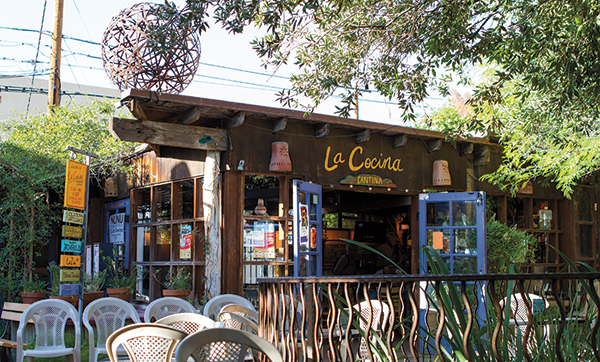
Old Town Artisans
Adobe Artisans:
Old Town Artisans
201 North Court Ave.
www.oldtownartisans.com
This mid-1800s adobe complex has been a distillery, private residence, gasoline station and grocery through many iterations, and was owned by parking lot king Don Jones before being purchased by the Cele Peterson family. You can still see original saguaro cactus rib ceilings and odd signage in the complex’s nooks and crannies.
The Vibe: Without question, the courtyard with its mature plantings draws you in, encircling you with history, culture and shopping. Because the La Cocina Restaurant, Cantina and Coffee Bar routinely hosts performances, visitors may visit the courtyard to relax, enjoy food and spirits, shop and have a total experience. Jewelry artist Eddie Gallego is the courtyard’s veteran artist, part of Old Town Artisans since 1991 He regularly hosts traditional Aztec performances and displays ofrendas honoring Día De Los Muertos observances.
Intriguing Times to Visit: With the grill open till the wee hours and the performance venue hopping almost every night, Old Town Artisans can be your shopping, cultural and cuisine experience whenever you fancy one. The La Cocina stage also is Tucson Folk Festival venue on May 4-5. Tolteca Tlacuilo hosts fourth Saturday traditional art demonstrations; check the website for May or June programs.
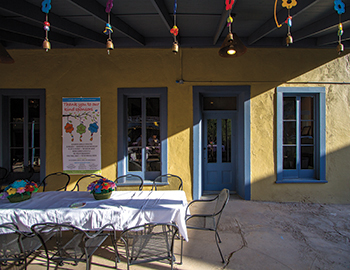
Ben’s Bells Courtyard
Kindness Collective:
Ben’s Bells Downtown Courtyard
40 West Broadway
www.bensbells.org
Kindness has swept through downtown’s Charles Brown House and activated the courtyard of this historic complex. Once the site of Territorial Arizona’s Congress Hall and saloon, it’s now the downtown headquarters of the Ben’s Bells organization. A photography studio, shops, and nonprofit offices also hum around the courtyard. A nano-brewery-specialty coffee bar should open in June.
The Vibe: Ben’s Bells founder Jeannette Mare knows that courtyards are collaborative spaces for the curious and the creative. Interest grew for the original Ben’s Bells, she says, in part because of the outdoor visibility of its Geronimo Plaza, Main Gate location. The downtown courtyard is a welcoming space with outdoor kitchen, colorful tiles and historic plantings. Benches are shaded under historic arcades.
Intriguing Times to Visit: Kindness seekers of the community may stop in to create a mosaic bell during open studios, held Tuesday through Saturday, 10am-5pm. Check the Ben’s Bells website for a fall party and the opening of a Kindness Shop in line with street car construction completion.
Cottage Community:
Main Street Arts: Kaitlin’s Cottage & Dry River Collective
740 North Main Avenue
www.kaitlinmeadows.com or thundermoonstudios.wordpress.com
Around 1916, Wong Yu built his Sunnyside Grocery at the corner of North Main and University. Over the years this landmark has incubated many artist groups, through conservation efforts first by what was the John Spring Neighborhood preservationist team, and later by historian/developer Steve Leal, who purchased the structures for artist working spaces in 1986.
The Vibe: This unique complex of adobes and tin roof buildings still contain historic touches from when railroad workers and Wong Yu’s mercantile operation were first housed there. The courtyard, with huge, 100-year-plus trees, also contains a garden cultivated by one anchor artisan, Kaitlin’s Creative Cottage and Thunder Moon Collective. Other tenants include Read Between the Bars collective, a sound editor, bronze artist, weaver, as well as southwest impressionist artist Jack Bybee. Signs for the Dry River radical resource collective still front the adobe, although “Tucson’s only anarchist-run establishment” is officially closed.
Intriguing Times to Visit: Kaitlin Meadows regularly hosts art classes and creative playdays for women as well as a number of all-inclusive community events. Check her website for news about Saturday open studios (also held by artist Bybee) and community programs to coincide with the full moon and El Día de San Juan day in June.
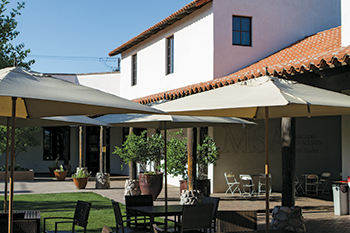
Mercado San Agustin
Mission & Market:
Mercado San Agustín
100 South Avenida del Convento
www.mercadosanagustin.com
Melding agriculture history and the hip urban fabric of open air markets, the Mercado opened to the public in May 2011. With architecture inspired by best practices of Spanish colonial design and modern green building ethics, the Mercado highlights heritage in its diverse assortment of small businesses and restaurants. The Mercado’s central courtyard is regularly activated by events and its weekly farmer’s market.
The Vibe: Wander around the arcade of small kiosks featuring traditional and locally-grown arts and eats. The Mercado offerings range from handcrafted moccasins to sno-cones and silver. Hang out, shop or enjoy an open air market that showcases a Mission heritage and locavore items processed in a shared commercial kitchen.
Intriguing Times to Visit: The award-winning Santa Cruz River Farmers Market is held every Thursday, 4-7pm. A Gay Pride fundraiser will be held June 22. Get set for the traditional July 4 “A” Mountain fireworks blowout, and a food truck event for Hot August Nights. Check website for details.
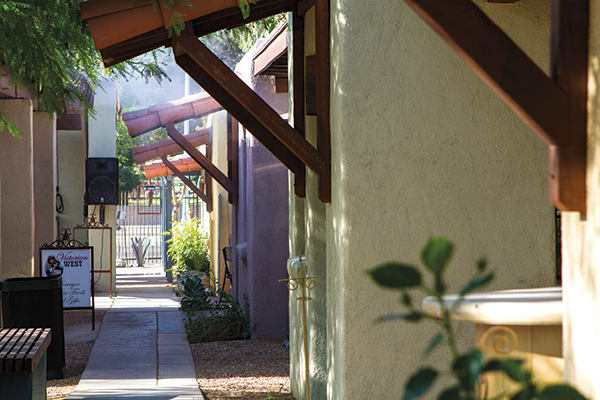
Monterey Court
Roundup Retro:
Monterey Court Studios & Cafe
505 West Miracle Mile
www.montereycourtaz.com
This 1938 motor court was the pride of Miracle Mile in its heyday, and after 18 months of renovation, partners Kelly McLear and Greg Haver opened the complex with 12 rental spaces for studios and shops, a café and park-like courtyard including performance stage.
The Vibe: So many original features including beams and signage have been preserved, so a walk around the spaces is a retro visual experience. Courtyards are magnets for people to generate ideas and collectively produce art, says McLear, who recalls musicians jamming and talking by the fireplace in the south courtyard this past winter. Garden art, metal sculptures and native plantings offer creative interest and green overhead shade for guests, who are found sitting solo reading books or sharing conversation with artists.
Intriguing Times to Visit: The Miracle Mile Neon Tour and Open House will be held May 10, with the free event starting and ending at the Monterey Court. Check the website for both a May 5 first anniversary celebration and a June 21 summer solstice party.
During summers, Tucson’s desert courtyards have a cadence all their own, seducing us with unique conversation or diversions. “Creative energy feeds from one to the next,” says Monica Prillaman, whose Obsidian Gallery in The Historic Depot is the scene of evening exhibits that often open up onto another of Tucson’s more unique courtyards. Here, there’s nothing like an art show evolving into a night stroll set against a backdrop of freight trains and stars.
Courtyards catering to every stripe are found all over this town. Go see how these mini-meccas will ignite your spirit, expand your expertise or find you in a new conversation.
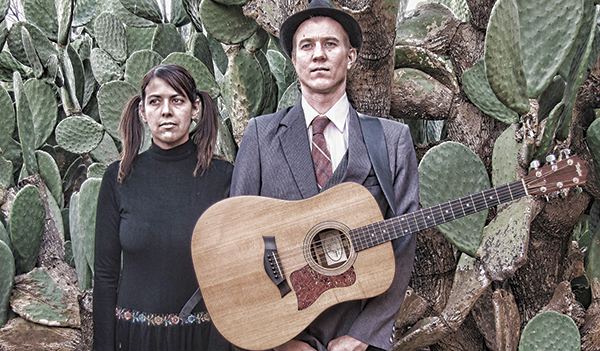
 For the younger set, summer brings free entertainment in the form of Loft Kids Fest (the event formerly known as the Tucson International Children’s Film Festival). Kickoff festivities at Trail Dust Town on Friday, July 19 at 5:30 pm include trick roping by lariat artist Loop Rawlins, followed by a screening of his short The Adventures of Loop & Rhett. Trail Dust Town’s homage to the Old West can be found at 6541 E. Tanque Verde Rd.
For the younger set, summer brings free entertainment in the form of Loft Kids Fest (the event formerly known as the Tucson International Children’s Film Festival). Kickoff festivities at Trail Dust Town on Friday, July 19 at 5:30 pm include trick roping by lariat artist Loop Rawlins, followed by a screening of his short The Adventures of Loop & Rhett. Trail Dust Town’s homage to the Old West can be found at 6541 E. Tanque Verde Rd. Indulging oneself for a good cause is always a win-win; thus the 2013 Salsa & Tequila Challenge. A $40/person ticket price benefits the Southern Arizona Arts and Cultural Alliance as well as the Community Food Bank of Southern Arizona. The question is, are you up for it? There’ll be as many as fifty tequila-based mixed drink and menu pairings presented by area chefs with bragging rights at stake, plus creative salsa concoctions galore, so you may want to begin training. The competition takes place at La Encantada shopping center, 2905 E. Skyline Dr., on Saturday, August 24 at 5:30 pm with winning tequilas and salsa announced the same evening. Purchase tickets online at SAACA.org or by telephone at (520) 797-3959 ext. 1.
Indulging oneself for a good cause is always a win-win; thus the 2013 Salsa & Tequila Challenge. A $40/person ticket price benefits the Southern Arizona Arts and Cultural Alliance as well as the Community Food Bank of Southern Arizona. The question is, are you up for it? There’ll be as many as fifty tequila-based mixed drink and menu pairings presented by area chefs with bragging rights at stake, plus creative salsa concoctions galore, so you may want to begin training. The competition takes place at La Encantada shopping center, 2905 E. Skyline Dr., on Saturday, August 24 at 5:30 pm with winning tequilas and salsa announced the same evening. Purchase tickets online at SAACA.org or by telephone at (520) 797-3959 ext. 1. De Anza Drive-In may be history, but Tucson’s love affair with watching movies outdoors continues. Cinema La Placita’s longest-running classic-movies-under-the-stars series screens an older Hollywood gem for $3 admission each Thursday evening at 7:30 pm through August. That price includes popcorn, and the courtyard setting at 110 S. Church Ave. is ideal for canoodling. Cinema La Placita will also show a film at 7:30 pm on Saturday, July 13 as part of the month’s Second Saturdays Downtown celebration. Visit CinemaLaPlacita.com for more information.
De Anza Drive-In may be history, but Tucson’s love affair with watching movies outdoors continues. Cinema La Placita’s longest-running classic-movies-under-the-stars series screens an older Hollywood gem for $3 admission each Thursday evening at 7:30 pm through August. That price includes popcorn, and the courtyard setting at 110 S. Church Ave. is ideal for canoodling. Cinema La Placita will also show a film at 7:30 pm on Saturday, July 13 as part of the month’s Second Saturdays Downtown celebration. Visit CinemaLaPlacita.com for more information.


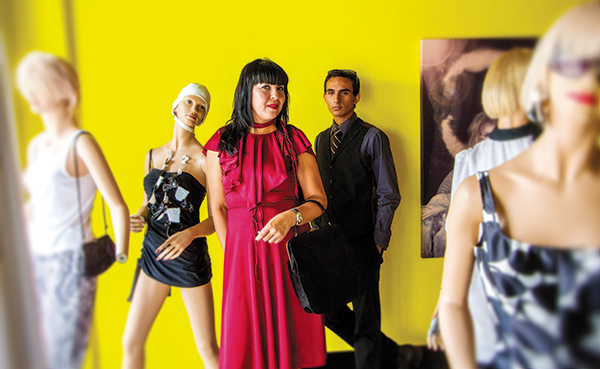
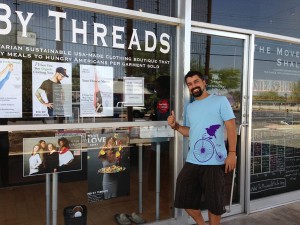







 As professional baseball sunsets in Tucson, FC Tucson is reached amazing heights even before a soccer-dedicated stadium is built. FC Tucson starts its second season May 18 as a Premier Development League team, essentially AA soccer minor league. Beyond its own games, FC Tucson has made it a point to pair each of its games this season with games involving champion teams from a half dozen local soccer leagues. The Chapman Tucson Champions League was just announced April 23.
As professional baseball sunsets in Tucson, FC Tucson is reached amazing heights even before a soccer-dedicated stadium is built. FC Tucson starts its second season May 18 as a Premier Development League team, essentially AA soccer minor league. Beyond its own games, FC Tucson has made it a point to pair each of its games this season with games involving champion teams from a half dozen local soccer leagues. The Chapman Tucson Champions League was just announced April 23.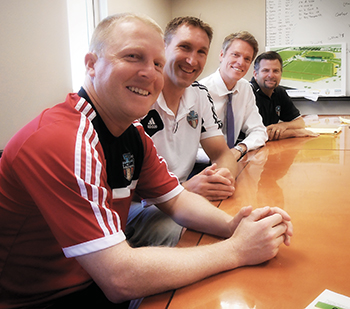

 The Sunshine Mile revival started with a tour: last November, Demion Clinco from Tucson Historic Preservation Foundation found himself on Broadway Boulevard, organizing talks for the inaugural Modernist Week on the mid-Century modern architecture that populates a particular corridor of the boulevard. It was a spark of history that’s now revitalizing the business district. “This section of Broadway between Euclid and Country Club was born modern,” Clinco begins. The decades after World War II saw both an explosion in Tucson’s population and the birth of the Modernist era; the economy traveled east from downtown, using Broadway as its main thoroughfare and prominent, innovative architects in its construction. Now even in the midst of contemporary buck-saving commercial architecture, we’ve been left with so many modernist gems that the Arizona Preservation Foundation added the Sunshine Mile to its list of endangered historical places. They’re in danger of being forgotten and potentially erased by a long-standing proposal to widen the street and tear down encroaching buildings on its north side.
The Sunshine Mile revival started with a tour: last November, Demion Clinco from Tucson Historic Preservation Foundation found himself on Broadway Boulevard, organizing talks for the inaugural Modernist Week on the mid-Century modern architecture that populates a particular corridor of the boulevard. It was a spark of history that’s now revitalizing the business district. “This section of Broadway between Euclid and Country Club was born modern,” Clinco begins. The decades after World War II saw both an explosion in Tucson’s population and the birth of the Modernist era; the economy traveled east from downtown, using Broadway as its main thoroughfare and prominent, innovative architects in its construction. Now even in the midst of contemporary buck-saving commercial architecture, we’ve been left with so many modernist gems that the Arizona Preservation Foundation added the Sunshine Mile to its list of endangered historical places. They’re in danger of being forgotten and potentially erased by a long-standing proposal to widen the street and tear down encroaching buildings on its north side.
 For Katie Treat, owner of Posh Petals, setting up her new shop in the historic Tophy Building has brought her into the fold of 4th Avenue. Posh Petals specializes in custom flowers for events, so the retail space is a bit of a blank canvas. It’s a comfortable shop that she’s filled with funky antiques, artful glass vases, flower boxes, pots, and votives.
For Katie Treat, owner of Posh Petals, setting up her new shop in the historic Tophy Building has brought her into the fold of 4th Avenue. Posh Petals specializes in custom flowers for events, so the retail space is a bit of a blank canvas. It’s a comfortable shop that she’s filled with funky antiques, artful glass vases, flower boxes, pots, and votives.



Also find us on...